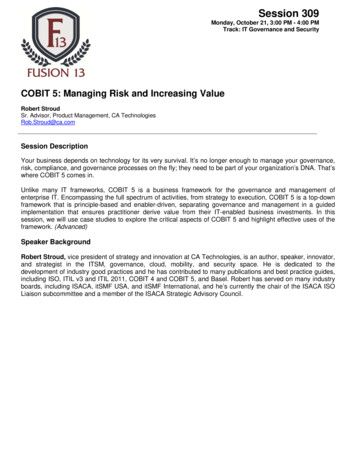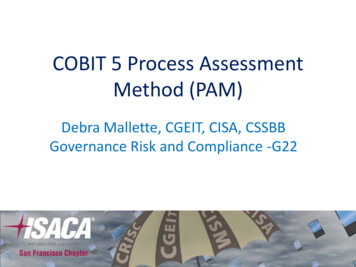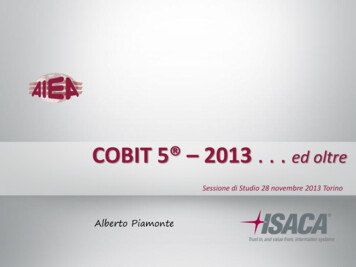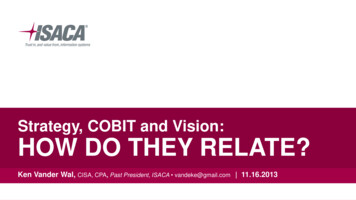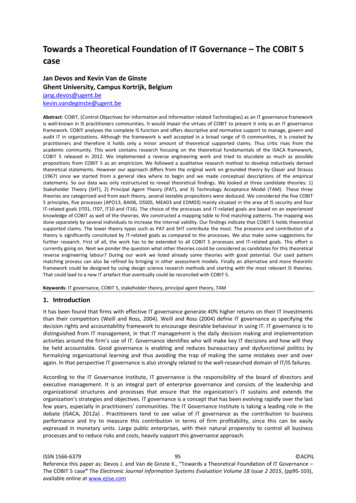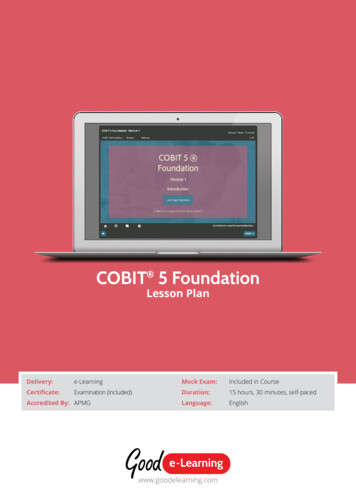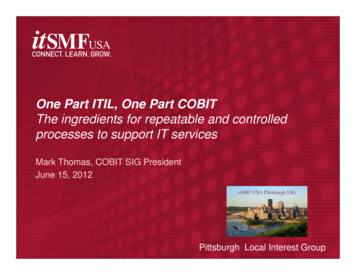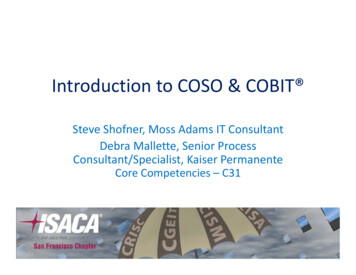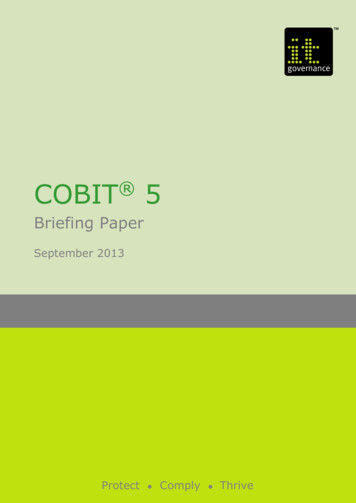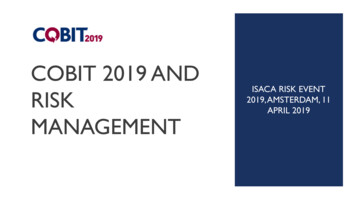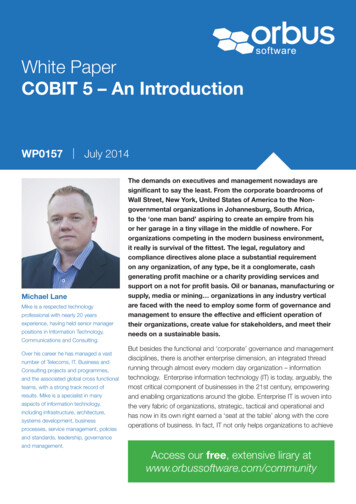
Transcription
White PaperCOBIT 5 – An IntroductionWP0157 July 2014Michael LaneMike is a respected technologyprofessional with nearly 20 yearsexperience, having held senior managerpositions in Information Technology,Communications and Consulting.Over his career he has managed a vastnumber of Telecoms, IT, Business andConsulting projects and programmes,and the associated global cross functionalteams, with a strong track record ofresults. Mike is a specialist in manyaspects of information technology,including infrastructure, architecture,systems development, businessprocesses, service management, policiesThe demands on executives and management nowadays aresignificant to say the least. From the corporate boardrooms ofWall Street, New York, United States of America to the Nongovernmental organizations in Johannesburg, South Africa,to the ‘one man band’ aspiring to create an empire from hisor her garage in a tiny village in the middle of nowhere. Fororganizations competing in the modern business environment,it really is survival of the fittest. The legal, regulatory andcompliance directives alone place a substantial requirementon any organization, of any type, be it a conglomerate, cashgenerating profit machine or a charity providing services andsupport on a not for profit basis. Oil or bananas, manufacturing orsupply, media or mining organizations in any industry verticalare faced with the need to employ some form of governance andmanagement to ensure the effective and efficient operation oftheir organizations, create value for stakeholders, and meet theirneeds on a sustainable basis.But besides the functional and ‘corporate’ governance and managementdisciplines, there is another enterprise dimension, an integrated threadrunning through almost every modern day organization – informationtechnology. Enterprise information technology (IT) is today, arguably, themost critical component of businesses in the 21st century, empoweringand enabling organizations around the globe. Enterprise IT is woven intothe very fabric of organizations, strategic, tactical and operational andhas now in its own right earned a ‘seat at the table’ along with the coreoperations of business. In fact, IT not only helps organizations to achieveand standards, leadership, governanceand management.Access our free, extensive lirary atwww.orbussoftware.com/community
their goals and objectives, but plays an ever increasing essential role insetting the strategic direction of enterprises.So you can understand that with information technology having becomeso important, effective governance and management of this Enterprise ITis critical to the success of organizations today. Forming part of the overallenterprise governance and management of organizations, the governanceand management of Enterprise IT needs a sound, structured framework toassure organizations are doing the right things, and doing them right whenit comes to information technology. Many an IT Executive and Managerhas despaired at the very thought of taking on the governance andmanagement of their organization’s investment and future in informationtechnology, but they need not have, help is well and truly at hand.Despite its incredible global reach and growing prevalence, there are stillmany out there who know little or nothing about COBIT 5 – the businessframework for the governance and management of Enterprise IT. If youare one of these people keep reading and you will find yourself goingfrom being in the dark, to seeing the governance and managementof information technology in your organization in a whole new light.Welcome to COBIT 5!The Basics of COBIT 5History of COBITCOBIT, at origination, was an abbreviation for Control Objectives forInformation and related Technology. Nowadays it is simply known asCOBIT. Originally conceptualized with a focus on Auditing in the area ofInformation Technology in 1996, its scope has evolved over the yearsmoving through foci of Control Objectives, Management Guidelines, andIT Governance to current day, where, in its latest release, COBIT 5 of2012, the scope and focus is on holistic Governance and Managementof Enterprise IT. This most recent edition provides for an end-to-endbusiness view of the governance of enterprise IT that reflects the centralrole of information and technology in creating value for enterprises.Figure 1 (COBIT 5, 2012 ISACA All rights reserved)2 Orbus Software 2014
According to ISACA, “COBIT 5 provides a comprehensive, holisticframework that helps enterprises to achieve their goals and deliver valuethrough effective governance and management of enterprise IT.” (ISACA2012, 5)COBIT 5 builds and expands on COBIT 4.1 by integrating other majorframeworks, standards and resources, including ISACA’s Val IT andRisk IT, Information Technology Infrastructure Library (ITIL ) and relatedstandards from the International Organization for Standardization (ISO)like ISO 38500:2008 Corporate Governance of IT. COBIT 5 also alignsitself at a high level with existing frameworks such as TOGAF , PMBOK and PRINCE 2 which makes it an umbrella for governance andmanagement.Figure 2 (COBIT 5, 2012 ISACA All rights reserved)Governance and ManagementThe official definition is – “A Business Framework for the Governance and Management ofEnterprise IT.” (ISACA 2012)When forming an understanding of COBIT 5, it is useful to understandwhat the words Governance and Management mean, and thenspecifically, their meaning in the context of information technology.Management “Manage” comes from the Italian maneggiare (to handle, especiallytools), which derives from the Latin word manus management) “Management in business and organizations is the function thatcoordinates the efforts of people to accomplish goals and objectivesusing available resources efficiently and effectively. Management3 Orbus Software 2014
comprises planning, organizing, staffing, leading or directing, andcontrolling an organization or initiative to accomplish a ent.html)Governance “Governance” is derived from the Greek verb kubernáo meaning “to Enterprise-IT.html)“Governance refers to all processes of governing, whether undertakenby a government, market or network, whether over a family, tribe, formalor informal organization or territory and whether through laws, norms,power or /governance.htm)But what is Governance and Management in the domain of informationtechnology? Let’s consider the below definitions from Gartner Gartner IT Governance Definition:- I T governance (ITG) is defined as the processes that ensure theeffective and efficient use of IT in enabling an organization to achieveits goals. IT demand governance (ITDG—what IT should work on) isthe process by which organizations ensure the effective evaluation,selection, prioritization, and funding of competing IT investments;oversee their implementation; and extract (measurable) businessbenefits. ITDG is a business investment decision-making and oversightprocess, and it is a business management responsibility. IT supplyside governance (ITSG—how IT should do what it does) is concernedwith ensuring that the IT organization operates in an effective, efficientand compliant fashion, and it is primarily a CIO it-governance)Gartner IT Management Definition:- I T management services provide day-to-day management andoperation of IT assets and processes. As such, they representthe core value components of ITO*. IT management servicesare divided into three key sub-segments: operations services(for IT infrastructure), application management services and helpdesk management services. * IT operations as the people andmanagement processes associated with IT service management todeliver the right set of services at the right quality and at competitivecosts for erations)4 Orbus Software 2014
Bearing the definition from Gartner in mind and with the emphasis placedfirmly on Governance in COBIT 5, it is important to look at how the ITGovernance Institute (ITGI) defines Governance:- The responsibility of executives and the board of directors; consistsof the leadership, organizational structures and processes thatensure that the enterprise’s IT sustains and extends the enterprise’sstrategies and objectives[IT Governance Institute (ITGI)]Business needs are the inputs and drivers for every Enterprise andwithout Governance and Management in place, an organizationsprobability of meeting its strategies and objectives would be significantlyreduced. Let’s now take a closer look at these two critical domains withinthe COBIT 5 framework.Figure 3 (COBIT 5, 2012 ISACA All rights reserved)IT Governance is an integral part of the overall corporate ororganizational governance of the business. The design and operationof the Enterprise IT environment is therefore a critical component,requiring sound governance to ensure that it enables and empowers theorganization to realize its objectives.In COBIT 5, the governance domain ensures that enterprise andinformation technology objectives are achieved by evaluating stakeholderneeds, conditions and options; setting direction through prioritization anddecision making; and monitoring performance, compliance and progressagainst agreed-on direction and objectives.IT Management forms an integral part of the strategic management ofthe Enterprise, which is responsible for setting long term organizationalgoals, and translating these into tactical and short-term goals andobjectives.In COBIT 5, the management domain plans, builds, runs and monitorsactivities in alignment with the direction set by the governance body5 Orbus Software 2014
to achieve the enterprise and information technology objectives. Theresponsibility areas of plan, build, run and monitor each have their own focus: Align, Plan and Organize (APO) – focus on the use ofinformation and technology and how best it can be used toachieve a company’s goals and objectives. Build, Acquire and Implement (BAI) – focus on identifying ITrequirements, acquiring the technology, and implementing IT withinthe company’s current business processes. Deliver, Service and Support (DSS) – focus on the deliveryaspects of the information technology. Monitor, Evaluate and Assess (MEA) – focus on a company’sstrategy in assessing the needs of the company and whether ornot the current Enterprise IT meets the objectives for which it wasdesigned and the controls necessary to comply with regulatoryrequirements.But having Governance and Management domains and sub-domainsis not in itself all-encompassing, there is much more to the COBIT5 framework. The framework is extensive and comprehensive, andincludes Governance of Enterprise IT (GEIT), Principles, Enablers,Processes, Practices and Activities, Goals and Metrics, Inputs andOutputs, RACI Charts and Process Capability Assessments.In other words, COBIT 5 is a single, integrated framework of globallyaccepted principles, practices, analytical tools and models to notonly shape the governance and management of enterprise IT inyour business, but that optimizes your investment in information andtechnology for the benefit of all stakeholders.What COBIT 5 does so efficiently and effectively is define and bringtogether five principles that allow the enterprise to build an effectivegovernance and management framework based on a holistic setof seven enablers, five domains and 37 processes that optimizesinformation and technology investment and use for the benefit of allstakeholders.Five PrinciplesPrinciple 1: Meeting Stakeholder Needs – stakeholders need value tobe created by the Enterprise. Value to the stakeholder and the Enterprisemeans realizing benefits, with optimal risk and cost of resourcing. Tomeet these expectations, it is essential for an organization to have anenterprise governance objective of value creation.Principle 2: Covering the Enterprise End-to-end - governanceof enterprise IT (GEIT) is an integral part of enterprise governance,and needs to encompass the entire Enterprise end-to-end. The GEITextends to all functions in the organization, where IT is present, therefore6 Orbus Software 2014
covering the Enterprise integrally and holistically.Principle 3: Applying a Single Integrated Framework - there area multitude of standards and frameworks used by enterprises today:COSO; COSO ERM; ISO/IEC 9000; ISO/IEC 31000; ISO/IEC 38500;ITIL, ISO/IEC 27000 series; TOGAF; PMBOK/PRINCE2 and CMMI.COBIT 5 aims to provide a single integrated framework for governanceand management of Enterprise IT, spanning all IT activities in theorganization and aligned to industry best practices, standards andframeworksPrinciple 4: Enabling a Holistic Approach – by identifying enablersacross the organization as a whole, COBIT ensures a holistic andeffective approach to the governance and management of EnterpriseIT. It is these seven Enablers which together empower the Enterprise toachieve its goals.Principle 5: Separating Governance from Management –governance and management are not one in the same discipline. Thepurpose, objectives, activities and organizational structure of each isunique and distinct from the other. As such COBIT clearly separatesgovernance from management in its framework.Figure 4 (COBIT 5, 2012 ISACA All rights reserved)Seven Enablers Principles, policies and frameworks provide practical guidancefor day-to-day management and tasks, and inform the requiredbehavior across the organization. Processes define how to translate inputs into outputs requiredby the Enterprise, to perform its organizational tasks and activities7 Orbus Software 2014
in a standardized manner, and to help the achievement of IT andEnterprise goals. Organizational structures bring together the other enablers in aform that enables the organization to deliver on its strategies, coordinate and manage its resources, and facilitate decision makingacross the Enterprise Culture, ethics and behavior of the organizations employees,and the entity itself, are critical success factors for the sustainablegovernance and management of Enterprise IT and the creation ofvalue. I nformation is often referred to as the lifeblood of the organization,running through all its veins, and essential for the effective andefficient operation, management and governance of the Enterprise. S ervices, infrastructure and applications provide the layers oftechnology and information required by the Enterprise P eople, skills and competencies are vital in every Enterprise,providing the human capital required to produce the Enterprise’sproducts/services, make effective decisions and taking anycorrective actions necessaryFigure 5 (COBIT 5, 2012 ISACA All rights reserved)Process Reference ModelThere are 37 process within the COBIT 5 framework, spread acrossthe Governance domain (5 processes) and Management domain (32processes), covering everything required for governance and managementof Enterprise IT. The latter 32 processes of the Management domain canfurther be broken down across the sub-domains as follows:- Align Plan and Organize (APO) – 13 processes- Build Acquire and Implement (BAI) – 10 processes- Deliver Service and Support (DSS) – 6 processes- Monitor Evaluate and Assess (MEA) –3 processes8 Orbus Software 2014
Figure 6 (COBIT 5, 2012 ISACA All rights reserved)To realize the benefits of the COBIT 5 framework, of course, it needs tobe implemented in your organization. It’s also important to understandthat implementing COBIT 5 is only the beginning, the start of yourjourney into the governance and management of Enterprise IT inyour organization. The emphasis in a COBIT 5 implementation is on acontinuous lifecycle.ImplementationThe recommended approach for the implementation of COBIT 5 is via aseven phase implementation lifecycle. Each phase contains ProgrammeManagement, Change Enablement and Continuous Improvementcomponents which ensure the implementation programme is managedeffectively, behavioral and cultural aspects are addressed and that it isnot a once-off initiative.Figure 7 (COBIT 5, 2012 ISACA All rights reserved)9 Orbus Software 2014
The implementation lifecycle moves through seven phases from whenthe need to act is recognized, the desire to change established andprogramme initiated in Phase 1, all the way to Phase 7 where theeffectiveness of the programme and sustainability of the improvementsare reviewed, new requirements for governance and management ofEnterprise IT identified, and the essentiality of continual improvementreinforced. Then the lifecycle starts all over again.1. Phase 1 asks What are the drivers?2. Phase 2 asks Where are we now?3. Phase 3 asks Where do we want to be?4. Phase 4 asks What needs to be done?5. Phase 5 asks How do we get there?6. Phase 6 asks Did we get there?7. Phase 7 asks How do we keep the momentum going?The Seven Phases and the three components within each phase providean integrated, cohesive and comprehensive implementation lifecycle.BenefitsThe COBIT 5 framework, focused on governance and management ofEnterprise IT, is today helping organizations around the world to realizesignificant benefits. Some of these benefits include the ability to:- Provide quality information for effective enterprise decision making- Govern and manage Information- Maximize trust in and value from Information and Technologysystems and investments, for internal and external stakeholders- Maintain high-quality information to support business decisions- Achieve strategic goals and realize business benefits through theeffective and innovative use of IT- Achieve operational excellence through reliable, efficient applicationof technology- Maintain an acceptable level of IT-related risk- Optimize the cost of IT services and technology- Simplify complex standards- Support compliance with relevant laws, regulations, contractualagreements and policies10 Orbus Software 2014
COBIT 5 FamilyThe COBIT 5 framework is not an isolated framework, in fact there isactually a COBIT 5 family. This COBIT 5 family contains the COBIT 5business framework itself, along with a series of Enabler and Professionalguides. There is also a new expanded and improved online experiencewith COBIT 5 online which will unfold through to completion over 2014.And more publications are imminent, like the forthcoming - Controls andAssurance in the Cloud: Using COBIT 5 – due 2nd quarter 2014.Figure 8 (COBIT 5, 2012 ISACA All rights reserved)ConclusionsMany refer to the 21st century as the information age. There is noquestion that information and the technologies which supply anddemand it, continue to become exponentially pervasive in everyday life.Both information and information technology have become securelyembedded in the strategic management of the modern day organization.This strategic position has duly warranted a heightened focus ongoverning and managing all aspects of information technology in theEnterprise. After all, as with any critical asset, tangible or intangible, onewould want to be assured that value is being generated, and that costsand risks are optimized. In fact, board and executive stakeholders notonly seek this assurance, but demand it, as an essential component ofthe organization’s enterprise governance and a measure of enterpriseperformance.The pressure and challenge of defining and implementing IT governanceand management processes has resulted in many organizations fallingshort when it comes to the governance and management of theirenterprise IT. If only they had been fortunate enough to know aboutCOBIT 5 and the COBIT 5 family.COBIT 5 not only provides a business framework for the governance andmanagement of Enterprise IT, it focuses on reducing risk, optimizing cost11 Orbus Software 2014
and maximising value and returns from your investments in informationtechnology. It is no surprise that it is arguably the most comprehensive,generally accepted and in use framework focused on governance andmanagement of Enterprise IT globally.The need for Governance and Management of Enterprise IT isundisputed, and so too should be the choice of framework to use. InCOBIT 5 there is a practical and available means to govern and manageinformation and technology, which can be used by a multitude ofstakeholders in any organization anywhere in the world to drive businessvalue and enable the achievement of business goals and objectives.COBIT 5 really is the smart choice for the Governance and Managementof your Enterprise IT.For information further to this introductory paper on COBIT 5,visit www.isaca.orgReferencesISACA (2012). A Business Framework for the Governance andManagement of Enterprise IT [PDF] Available er2-FrameWork.pdf[Accessed April 2014]ISACA (2012). COBIT 5 Introduction [PDF] Available duction.pdf[Accessed April 2014]IT Governance Institute IT GOVERNANCE USING COBIT AND VALITTM: TIBO CASE STUDY, 2ND EDITION [PDF] Available den/mac8287/cobit%20case%20study.pdf[Accessed in March ly.aspxBernard, P. (2012) COBIT - A Management Guide. Van HarenPublishing, (2012) Copyright 2014 Orbus Software. All rights reserved.No part of this publication may be reproduced, resold, stored in a retrieval system, or distributed in any form or by any means,electronic, mechanical, photocopying, recording, or otherwise, without the prior permission of the copyright owner.Such requests for permission or any other comments relating to the material contained in this document may be submittedto: marketing@orbussoftware.comOrbus Software3rd Floor111 Buckingham Palace RoadLondonSW1W 0SRUnited Kingdom 44 (0) 870 991 om
Welcome to COBIT 5! The Basics of COBIT 5 History of COBIT COBIT, at origination, was an abbreviation for Control Objectives for Information and related Technology. Nowadays it is simply known as COBIT. Originally conceptualized with a focus on Auditing in the area of Information
